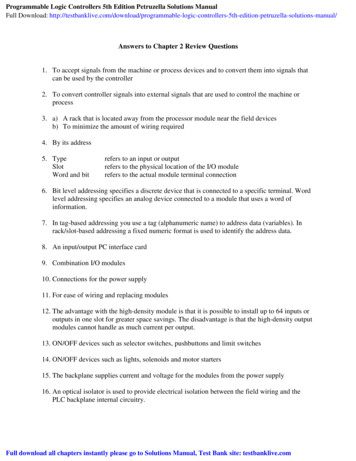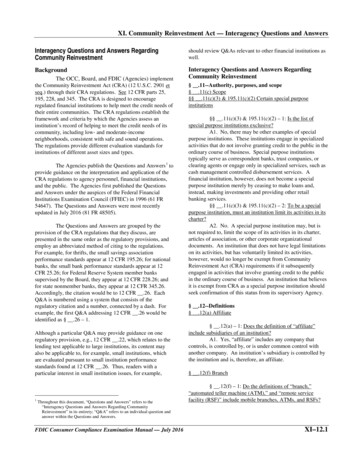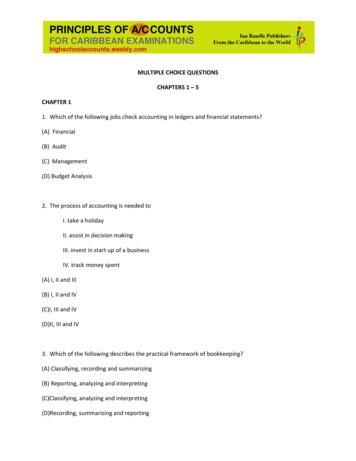
Transcription
Programmable Logic Controllers 5th Edition Petruzella Solutions ManualFull Download: ual/Answers to Chapter 2 Review Questions1. To accept signals from the machine or process devices and to convert them into signals thatcan be used by the controller2. To convert controller signals into external signals that are used to control the machine orprocess3. a) A rack that is located away from the processor module near the field devicesb) To minimize the amount of wiring required4. By its address5. TypeSlotWord and bitrefers to an input or outputrefers to the physical location of the I/O modulerefers to the actual module terminal connection6. Bit level addressing specifies a discrete device that is connected to a specific terminal. Wordlevel addressing specifies an analog device connected to a module that uses a word ofinformation.7. In tag-based addressing you use a tag (alphanumeric name) to address data (variables). Inrack/slot-based addressing a fixed numeric format is used to identify the address data.8. An input/output PC interface card9. Combination I/O modules10. Connections for the power supply11. For ease of wiring and replacing modules12. The advantage with the high-density module is that it is possible to install up to 64 inputs oroutputs in one slot for greater space savings. The disadvantage is that the high-density outputmodules cannot handle as much current per output.13. ON/OFF devices such as selector switches, pushbuttons and limit switches14. ON/OFF devices such as lights, solenoids and motor starters15. The backplane supplies current and voltage for the modules from the power supply16. An optical isolator is used to provide electrical isolation between the field wiring and thePLC backplane internal circuitry.Full download all chapters instantly please go to Solutions Manual, Test Bank site: testbanklive.com
17. Power and Logic sections18. Senses when a signal is receivedConverts the input signal to the correct voltage levelIsolates the PLC from the input voltage or currentSends a signal to the processor indicating which sensor originated the signal19. Triac20. a) 1 amp per pointb) A control relay is connected to the output module. The contacts of the control relay arethen used to control the larger load.21. Transistor22. A discrete relay-type module uses an electromechanical relay element for switching whichallow it to work for AC or DC applications.23. a) Sinking and sourcing are terms used to describe a current signal flow relationshipbetween field input and output devices in a control system and their power supply.b) Sourcing24. Discrete I/O modules allow only ON/OFF devices to be connected. Analog I/O modulesallow analog or varying voltage or current devices to be connected.25. Used to convert analog signals to an equivalent digital value26. Used to convert digital signals to an equivalent analog value27. Voltage sensing and current sensing28. Temperature, speed, level, flow, weight, pressure, and position29. A twisted shielded pair cable is used in wiring the circuit to reduce unwanted electrical noisesignals that can be induced in the conductors from other wiring30. Unipolar modules can accept an input signal that varies in the positive direction only. Bipolarsignals swing between a maximum negative value and a maximum positive value.31. The analog input channel is capable of sensing voltages down to 0.3V increments.32. The loop power may be supplied by the sensor or may be provided by the analog outputmodule33. Control valves, chart recorder, electronic drives
34. a) Used to count pulses such as motor encoders that occur at very high speedsb) Allows the use of thumbwheel switches for feeding information to a PLCc) Allows the transmitting and receiving of TTL signals for communication with the PLC’sprocessord) Used to monitor the output of incremental or absolute encoderse) Allows the transmitting and receiving of ASCII filesf) Provides pulse trains to a stepper-motor translator, which enables control of a steppermotorg) Enables a PLC to operate devices that require BCD-coded signals35. a) Used to maintain a process variable such as temperature, flow, level, or speed within setlimits of a specified set point.b) Used in applications involving accurate high-speed machining and packaging operationsc) Used to establish point-to-pint connections with other intelligent devices for the exchangeof data36. a) Specifies the magnitude and type of voltage signal that will be accepted by the inputb) Specifies a minimum ON-state voltage that is the minimum voltage at which logic 1 isrecognized as absolutely ON; and a maximum OFF-state voltage which is the voltage atwhich logic 0 is recognized as absolutely OFFc) Specifies the minimum input current that the input devices must be capable of driving tooperate the input circuitd) Specifies what the maximum temperature of the air surrounding the I/O modules shouldbe for best operating conditionse) Specifies the maximum time duration required by an input module's circuitry torecognize that a field device has switched ON (input ON-delay) or switched OFF (inputOFF-delay)f) Specifies the magnitude and type of user supply voltage at which a discrete outputmodule is designed to operateg) Specifies the maximum current that a single output and the module as a whole can safelycarry under load (at rated voltage)h) Specifies the maximum inrush current and duration for which an output circuit canexceed its maximum continuous current ratingi) This specification will designate whether the particular module's design has individualprotection for each circuit or if fuse protection is provided for groups (e.g. 4 or 8) of outputsj) Specifies the amount of current still conducting through an output circuit even after theoutput has been turned offk) Rates the module's capacity for sustaining an excessive voltage at its input or outputterminall) This specification defines the number of field inputs or outputs that can be connected to asingle modulem) This value indicates the amount of current the module requires from the backplane37. a) Specifies the number of analog channels that can be connected to the moduleb) The voltage or current signal ranges that an analog input module is designed to acceptc) This specification defines the current or voltage signal ranges that a particular analog
output module is designed to output under program controld) Analog input circuits are usually protected against accidentally connecting a voltage thatexceeds the specified input voltage rangee) This specification determines the smallest measureable unit of current or voltage themodule can measuref) For analog I/Os, these values must be matched to the external device connected to themoduleg) Refers to an analog module’s ability to prevent noise from interfering with data integrityon a single channel and from channel to channel on the module38. The CPU section executes the program and makes the decisions needed by the PLC tooperate and communicate with other modules. The memory section electronically stores thePLC program along with other retrievable digital information39. a) The power supply converts 115 VAC or 230 VAC into the usable DC voltage required bythe CPU, memory, and I/O electronic circuitryb) the length of time a PLC can tolerate a power loss40. Allows transfer of control to the second processor in the event of a processor fault41. Run mode, program mode, and remote mode42. Timing, counting, latching, comparing, motion control and complex math functions43. Ground yourself by touching a conductive surface before handling static-sensitivecomponentsWear a wrist strap that provides a path to bleed off any charge that may build up during workBe careful not to touch the backplane connector or connector pins of the PLC system (alwayshandle the circuit cards by the edge if possible)Be careful not to touch other circuit components in a module when you configure or replaceits internal componentsWhen not in use, store modules in its static-shield bag.44. a) Data are stored in memory locations by a process called writingb) Data are retrieved from memory by what is referred to as readingc) Individual piece of memory in the form of 1’s or 0’sd) Memory location refers to an address in the CPU’s memory where a binary word can bestorede) Memory utilization refers to the number of memory locations required to store each typeof instruction45. a)b)c)d)The status of all input and output devices101
e) 046. To be sure that the PLC memory has not been corrupted47. Volatile: Loses all its stored information if all operating power is lost or removed. Memory iseasily altered and usually supported by a battery backup power supplyNonvolatile: Retains stored information when the power is accidentally or intentionallyremoved. Memory is generally unalterable.48. ROM is normally used to store the programs and data that define the capabilities of the PLC.49. RAM is used as a temporary storage area of data that may need to be quickly changed50. An EEPROM memory module is used to store, back up, or transfer PLC programs51. They are extremely fast at saving and retrieving files52. Allows the user to enter, change or monitor a PLC program53. Handheld programmers are compact, inexpensive, and easy to use but they have limiteddisplay capabilities.54. Appropriate programming software55. Typical capabilities of the programming software include on-line and off-line programediting, on-line program monitoring, program documentation, diagnosing malfunctions in thePLC and troubleshooting the controlled system56. One57. Replace hard-wired pushbuttons and pilot lights with realistic-looking iconsShow operations in graphic formatAllow the operator to change timer and counter presetsShow alarms, complete with time of occurrence and locationsDisplay variables as they change over time58. Set up the communication with the PLC.Create the tag database.Insert the graphical objects on the screen.Animate the objects.59. Values of process variables, such as flow, temperature over a period of time.60. The changing a input or output quantity from one notation to another.61. A transducer converts a field device's variable (e.g., pressure, temperature etc.) into a verylow-level electric signal (current or voltage).
62. A base tag defines a memory location where data are stored. An alias tag is used to create analternate name (alias) for a tag.
CHAPTER 2PLC Hardware ComponentsTEST 2 . 1Choose the letter that best completes the statement.1. A is an example of a device that could be used toAnswer1. dprovide a discrete input to a PLC.a) pushbuttonb) selector switchc) limit switchd) all of the above2. A is an example of an actuator that could be2. bcontrolled by a discrete output from a PLC.a) pushbuttonb) motor starterc) limit switchd) all of the above3. A/An input or output is a continuously variable3. dsignal within a designated range.a) discreteb) digitalc) BCDd) analogCopyright (c) 2017 McGraw-Hill Education. All rights reserved. No reproduction or distributionwithout the prior written consent of McGraw-Hill Education.1
4. One function of a PLC input interface module is to:4. aa) accept signals from field devices and convert theminto signals that can be used by the processor.b) convert signals from the processing unit into values thatcan be used to control the machine or process.c) input signals from the programming device and convert theminto signals that can be used by the CPU.d) interpret and execute the user program that controls the machineor process.5. The location of a specific input or output field device is5. didentified by the processor by means of its:a) voltage rating.c) wattage rating.b) current rating.d) address.6. A discrete output interface module is designed to provide:6. ca) output voltages only in the 5 VDC range.b) varying AC or DC voltages depending on the type of module selected.c) ON/OFF switching of the output field device.d) binary-coded outputs.7. The following statement that does not apply to the7. boptical isolator circuit used in I/O modules is that it:a) separates high voltage and low voltage circuitsb) rectifies AC signals.c) prevents damage caused by line voltage transients.d) reduces the effect of electrical noise.Copyright (c) 2017 McGraw-Hill Education. All rights reserved. No reproduction or distributionwithout the prior written consent of McGraw-Hill Education.2
8. Individual outputs of a typical AC output interface module8. ausually have a maximum current rating of about:a) 1 A or 2 A.c) 50 mA or 100 mA.b) 25 A or 50 A.d) 250 µA or 500 µA9. Which of the following input field devices would most9. dlikely be used with an analog interface input module?a) Pushbuttonc) Selector switchb) Limit switchd) Thermocouple10. The "ON state input voltage range" specification refers to:10. da) the type of voltage device that will be accepted by the input.b) range of leakage voltage present at the input in its ON state.c) minimum and maximum output operating voltages.d) voltage at which the input signal is recognized as being ON.11. Volatile memory elements can be classified as those that:11. aa) do not retain stored information when the power is removed.b) retain stored information when the power is removed.c) do not require a battery backup.d) both b and c.12. memory is used by the PLC's operating system.a) RAMc) Flashb) EEPROMd) ROMCopyright (c) 2017 McGraw-Hill Education. All rights reserved. No reproduction or distributionwithout the prior written consent of McGraw-Hill Education.12. d3
13. is a type of memory commonly used for temporary13. astorage of data that may need to be quickly changed.a) RAMc) EPROMb) ROMd) EEPROM14. The most common form of memory used to store, back up,14. dor transfer PLC programs is:a) RAMc) EEPROMb) Flash EEPROMd) both b and c15. In event of a power interruption, a is used in some15. bprocessors to provide power to the RAM.a) inductorc) transistorb) capacitord resistor16. Which of the following is not a function of a16. cPLC programming device?a) To enter the user programb) To change the user programc) To execute the user programd) To monitor the user program17. Status indicators are provided on each output17. dof an output module to indicate that the:a) load has been operated.b) input associated with the output is active.c) module fuse has blown.Copyright (c) 2017 McGraw-Hill Education. All rights reserved. No reproduction or distributionwithout the prior written consent of McGraw-Hill Education.4
d) output is active.18. The I/O system provides an interface between:18. ba) input modules and output modules.b) the CPU and field equipment.c) the CPU and I/O rack.d) the I/O rack and I/O modules.19. The PLC chassis comes in different sizes19. caccording to the:a) size of the program.c) number of slots they contain.b) type of I/O modules used.d) all of the above.20. The Allen-Bradley SLC-500 address I:2/4 refers to an:20. ca) Input module in slot 4, terminal 2.b) Output module in slot 4, terminal 2.c) Input module in slot 2, terminal 4.d) Output module in slot 2, terminal 4.21. The Allen-Bradley SLC-500 address O:3/0 refers to an:21. ba) Input module in slot 3, terminal 0.b) Output module in slot 3, terminal 0.c) Input module in slot 0, terminal 3.d) Output module in slot 0, terminal 3.22. For the I/O module of Figure 2-1, the arrows point to the:22. da) status indicator connections.Copyright (c) 2017 McGraw-Hill Education. All rights reserved. No reproduction or distributionwithout the prior written consent of McGraw-Hill Education.5
b) input connections.c) output connections.d) power supply connections.Figure 2-1 I/O module for question 22.23. For the block diagram of the input module shown in23. cFigure 2-2, Section #1 represents the and #2 the .a) AC, DC.b) DC, AC.c) power, logic.d) logic, power.Figure 2-2 Block diagram for question 23.Copyright (c) 2017 McGraw-Hill Education. All rights reserved. No reproduction or distributionwithout the prior written consent of McGraw-Hill Education.6
24-1. The schematic diagram of Figure 2-3 is that of a(n):a) discrete output module.c) discrete input module.b) analog output module.d) analog input module.24-1. c24-2. The purpose of the filter section is to:24-2. ca) aid in fault diagnosis.b) set the minimum level of voltage that can be detected.c) protect against electrical noise interference.d) separate the higher line voltage from the logic circuits .24-3 The purpose of the zener diode (ZD) is to:24-3. ba) aid in fault diagnosis.b) set the minimum level of voltage that can be detected.c) protect against electrical noise interference.d) separate the higher line voltage from the logic circuits .24-4 The purpose of the LED indicator is to:24-4. aa) aid in fault diagnosis.b) set the minimum level of voltage that can be detected.c) protect against electrical noise interference.d) separate the higher line voltage from the logic circuits .24-5 The purpose of the optical isolator is to24-5. da) aid in fault diagnosis.b) set the minimum level of voltage that can be detected.c) protect against electrical noise interference.d) separate the higher line voltage from the logic circuits .Copyright (c) 2017 McGraw-Hill Education. All rights reserved. No reproduction or distributionwithout the prior written consent of McGraw-Hill Education.7
Figure 2-3 Schematic diagram for question 24.25. For the block diagram of the output module shown in25. bFigure 2-4, the input comes from the:a) input field deviceb) processor.c) output field device.d) line power supply.Figure 2-4 Block diagram for question 25.26-1. The schematic diagram of Figure 2-5 is that of a(n):a) discrete output module.c) discrete input module.b) analog output module.d) analog input module.26-1. a26-2. The input signal to the module comes from:26-2. ca) the input field device.Copyright (c) 2017 McGraw-Hill Education. All rights reserved. No reproduction or distributionwithout the prior written consent of McGraw-Hill Education.8
b) the output field device.c) internal logic circuitry of the processor.d) either a or b.26-3 The purpose of the triac switch is to:26-3. aa) turn the load ON and OFF.b) vary the current flow to the load in accordance with the inputsignal level.c) vary the voltage across the load in accordance with the inputsignal level.d) both b and c.26-4 When the triac is in the OFF state:26-4. ba) zero current always flows through the load.b) a small leakage current may flow through the load.c) the rated surge current flows through the lamp.d) the rated nominal current flows through the lamp.Figure 2-5 Schematic diagram for question 26.Copyright (c) 2017 McGraw-Hill Education. All rights reserved. No reproduction or distributionwithout the prior written consent of McGraw-Hill Education.9
27. The schematic diagram of Figure 2-6 is an example of27. dhow a PLC output module is connected to:a) isolate the load from the controller.c) vary the speed of a motor.b) control a high resistance.d) control a high current load.Figure 2-6 Schematic diagram for question 27.28. Which of the following devices can be used for switching28. dthe output of a discrete DC output module?a) Transistor.c) relay.b) Triac.d) either a or c.29. The current sourcing sensor shown in Figure 2-729. amust be matched with a PLC input module.a) current sinking.b) current sourcing.c) alternating current.d) either a or b.Copyright (c) 2017 McGraw-Hill Education. All rights reserved. No reproduction or distributionwithout the prior written consent of McGraw-Hill Education.10
Figure 2-7 Current sourcing sensor for question 29.30. Typical analog inputs and outputs can vary from30. da) 0 to 20 mAb) 4 to 20 mAc) 0 to 10 voltsd) all of the above31. For the block diagram of the analog PLC control31. dshown in Figure 2-8, which part has a binaryinput and analog output value?a) Level transmitterc) Processorb) Input moduled) Output moduleFigure 2-8 Block diagram for question 31.Copyright (c) 2017 McGraw-Hill Education. All rights reserved. No reproduction or distributionwithout the prior written consent of McGraw-Hill Education.11
32-1 For the thermocouple analog input module32-1. ashown in Figure 2-9, shielded cable is used to:a) reduce unwanted electrical noise signals.b) carry the higher current required.c) lower the resistance of the conductors.d) insulate the circuit from other cables.32-2 The thermocouple shown is a:32-2. aa) ungrounded type with the shield grounded at the module end.b) ungrounded type with the shield grounded at the thermocouple end.c) grounded type with the shield grounded at the module end.d) grounded type with the shield grounded at the thermocouple end.Figure 2-9 Block thermocouple input module for question 32.33. The main element of an analog output module is:33. da) AC to DC rectifier.b) DC to AC inverter.c) analog to digital converter.d) digital to analog converter.Copyright (c) 2017 McGraw-Hill Education. All rights reserved. No reproduction or distributionwithout the prior written consent of McGraw-Hill Education.12
34. For the PLC analog I/O control system shown in34. aFigure 2-10, the fluid flow is controlled bya) varying the amount of the valve opening.b) switching the valve ON and OFF.c) switching the level sensor ON and OFF.d) varying the position of the level sensor.Figure 2-10 Analog I/O system for question 34.35. Which of the following special I/O modules would35. bbe used to operate a seven-segment LED Display?a) Encoder-counter module.b) BCD-output module.c) Stepper-motor module.d) High-speed counter module.36. A module is used to establish connections36. bfor the exchange of data.a) thumbwheelb) communicationc) servod) PIDCopyright (c) 2017 McGraw-Hill Education. All rights reserved. No reproduction or distributionwithout the prior written consent of McGraw-Hill Education.13
37. High-density I/O modules:37. aa) may have up to 64 inputs or outputs per module.b) require more space.c) can handle greater amounts of current per output.d) all of the above.38. Discrete I/O modules can be classified as:a) bit oriented.c) processor oriented.b) word oriented.d) power supply oriented.39. Which of the following specifications defines the number of38. a39. bfield inputs or outputs that can be connected to a single module?a) Electrical isolation.b) Points per module.c) Threshold voltage.d) Current per input.40. The of an analog I/O module specifies how40. caccurately an analog value can be represented digitally.a) number of inputs and outputs per cardb) input impedance and capacitancec) resolutiond) common mode rejection ratio41. The processor module of the PLC is where the:41. aa) ladder logic program is stored.b) input connections are made.Copyright (c) 2017 McGraw-Hill Education. All rights reserved. No reproduction or distributionwithout the prior written consent of McGraw-Hill Education.14
c) output connections are made.d) sensors are located.42. For the processor module shown in Figure 2-11,42. dBlock 1 represents the and Block 2 the .a) input, outputb) output, inputc) memory, CPUd) CPU, memoryFigure 2-11 Processor module for question 42.43. When placed in the mode, the processor43. adoes not scan/execute the ladder program.a) programc) testb) rund) remoteCopyright (c) 2017 McGraw-Hill Education. All rights reserved. No reproduction or distributionwithout the prior written consent of McGraw-Hill Education.15
44. The most commonly used programming device is a:44. aa) personal computer.b) dedicated industrial programming terminal.c) hand-held programmer.d) proprietary programming device.45. Electronic components found in PLC modules45. da) are not effected by electrostatic voltages.b) can be damaged by electrostatic voltages.c) can have their performance degraded by electrostatic voltages.d) both b and c.46. Batteries are used in a PLC's processor to46. ba) operate the status lights LEDs.b) maintain data in volatile memory when line power isremoved from the processor.c) maintain data in nonvolatile memory when line power isremoved from the processor.d) maintain outputs through a power failure.47. The tag is often used to create a tag name to represent47. ca real world input or output.a) baseb) predefinedc) aliasb) INTCopyright (c) 2017 McGraw-Hill Education. All rights reserved. No reproduction or distributionwithout the prior written consent of McGraw-Hill Education.16
48. The resizing of a signal to meet the requirements of the48. ausing component of a PLC system is known asa) scalingc) amplificationb) gradingb) protocol49. For the HMI package shown, the unlabeled block49. brepresents thea) processorc) input moduleb) tag databaseb) output module50. A fault condition which is present but the HMI alarm50. amessage has not been acknowledged by the operator issaid to be in the state.a) activec) readyb) inactiveb) OK51. Which of the following HMI program features provides the51 aability to chart the progress of a process in real time in amanner similar to that of a strip chart recorder?a) Tendc) Graphics Libraryb) Alarmsb) Event HistoryCopyright (c) 2017 McGraw-Hill Education. All rights reserved. No reproduction or distributionwithout the prior written consent of McGraw-Hill Education.17
CHAPTER 2PLC Hardware ComponentsTEST 2 . 2Place the answers to the following questions in theanswer column at the right.Answer1. An analog input or output is a signal that varies1. Truecontinuously within a certain range. (True of False)2. The I/O section of a PLC system can consist2. modulesof an I/O rack and individual I/O .3. The location of a module within a rack and the terminal 3. addressnumber of a module to which an input or output deviceis connected will determine the device's .4. Most input modules have blown fuse indicators.4. False(True or False)5. The I/O address is used by the processor to identify5. locatedwhere the device is .6. A standard I/O module consists of a(n)6a. circuit(a) board and a(n) (b) assembly.6b. terminalCopyright (c) 2017 McGraw-Hill Education. All rights reserved. No reproduction or distributionwithout the prior written consent of McGraw-Hill Education.18
7. I/O modules are designed to plug into a slot or connector. 7. True(True or False)8. Discrete I/O interfaces allow only type devices to8. ON/OFFbe connected.9. I/O modules' circuitry can be divided into two9a powerbasic sections: the (a) section and the9b logic(b) section.10. Optical isolation used in I/O modules helps to10. Truereduce the effects of electrical noise. (True or False)11. AC output modules often use a solid-state device11. Triacsuch as a(n) to switch the output ON and OFF.12. I/O modules are keyed to prevent unauthorized12. Falsepersonnel from removing them from the I/O rack.(True or False)13. The maximum current rating for the individual13. Falseoutputs of an AC output module is usually inthe 20 to 30 ampere range. (True or False)14. A(n) relay is used for controlling14. interposinglarger load currents.Copyright (c) 2017 McGraw-Hill Education. All rights reserved. No reproduction or distributionwithout the prior written consent of McGraw-Hill Education.19
15. Analog input interface modules contain15. Analog to Digitala(n) converter circuit.16. A thermocouple would be classified as an analog16. Trueinput sensing device. (True or False)17. Shielded twisted pair cable is used for connecting17. Trueto thermocouple inputs to reduce unwantedelectrical noise. (True or False)18. Electrical noise usually causes permanent18. Falseoperating errors. (True or False)19. Match each of the following specifications with the appropriate description.Place the number from the specifications list in the answer column.SPECIFICATIONS1) nominal current per input2) ON-state input voltage range3) OFF-state leakage current4) electrical isolation5) input delay6) nominal input voltage7) surge current8) output voltage range9) maximum output current rating10) nominal output voltageDESCRIPTIONSCopyright (c) 2017 McGraw-Hill Education. All rights reserved. No reproduction or distributionwithout the prior written consent of McGraw-Hill Education.20
a) Maximum voltage isolation between the I/O circuits19a. 4and the controller logic circuitry.b) Maximum value of current that flows through the19b. 3output in its OFF state.c) Maximum inrush current and duration an output19c. 7module can withstand.d) Maximum current that a single output and the19d. 9module as a whole can safely carry.e) Minimum and maximum output operating voltages.19e. 8f) Magnitude and type of voltage source that can be19f. 10controlled by the output.g) Duration for which the input must be ON before19g. 5being recognized as a valid input.h) Minimum input current that the input device must19h. 1be capable of driving to operate the input circuit.i) Voltage level at which the input signal is19i. 2recognized as being ON.j) Magnitude and type of voltage signal that will be19j. 6accepted by the input.20. The processor continually interacts with the20. I/Oto interpret and execute the user program.21. The processor may perform functions such as timing,21. Truecounting, and comparing in addition tologic processing. (True or False)Copyright (c) 2017 McGraw-Hill Education. All rights reserved. No reproduction or distributionwithout the prior written consent of McGraw-Hill Education.21
22. Memory is where the control plan is held or22. Truestored in the controller. (True or False)23. One is a memory location that may store one23. bitbinary number that has the value of either 1 or 0.24. A volatile memory will lose its programmed contents24. Trueif operating power is lost. (True or False)25. A nonvolatile memory will retain its programmed25. T
17. Power and Logic sections 18. Senses when a signal is received Converts the input signal to the correct voltage level Isolates the PLC from the input voltage or current Sends a signal to the processor indicating which sensor originated the signal 19. Triac 20. a) 1 amp per point b) A











